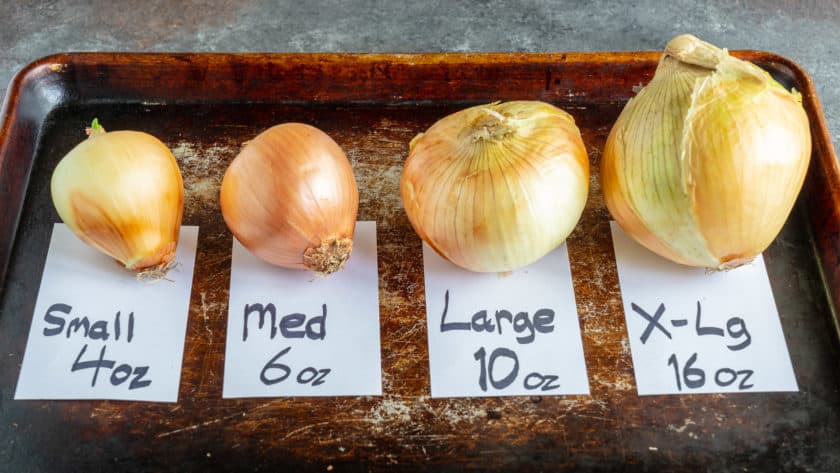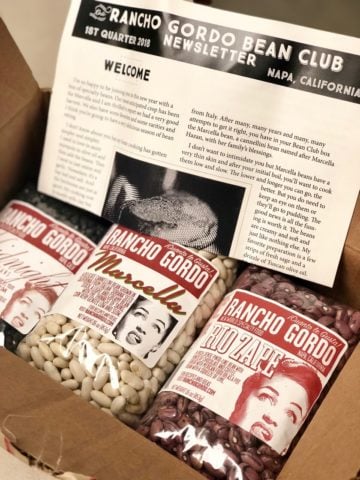
I don’t sweat onion size. Most of my recipes are flexible; if I call for a large onion and you use a medium onion, you’ll be fine. In other words, size doesn’t matter.
Except when it does.
I’m working on my vegetable broth recipe, and I want to get the right ratio of onion, celery, and carrot to water. (3:2 water to vegetables, and 3:2:1 onion to carrot to celery.) To do that right, I need to do it by weight; to give you instructions, I need to know what “2 large onions, chopped” actually means. Testing time! I went to the store, bought a range of onions, and got out my kitchen scale. Here’s what I found.
How much does a Small onion weigh?
5 ounces or less, averaging 4 ounces
How much does a Medium onion weigh?
5 to 8 ounces, averaging about 6 ounces
How much does a Large onion weigh?
8 to 12 ounces, averaging about 10 ounces
How much does an Extra-Large onion weigh?
12 ounces and up, averaging 16 ounces
| Onion | Average | Weight | Sports Ball |
|---|---|---|---|
| Size | Weight | Range | Comparison |
| Small | 4oz / 115g | 5 oz or less | Racquetball |
| Medium | 6oz / 170g | 5 to 8 oz | Baseball |
| Large | 10 oz / 285g | 8 to 12 oz | Softball |
| Extra-Large | 16oz / 454g | 12oz or more | Shot Put |
Most of the onions at the store are large to extra-large onions (in the onion bin) or medium (in a three-pound mesh bag.) I buy large onions - I want to pick good-looking ones from the bin. (That’s why most of my recipes call for large onions.)
What do the Feds have to say?
The USDA has a different grading standard, based on size instead of weight:
| Diameter | |
|---|---|
| Size Designation | (in inches) |
| Small | 1 to 2.25 |
| Repacker | 1.75 to 3 |
| Medium | 2 to 3.25 |
| Large | 3 and up |
| Colossal | 3.75 and up |
Resources:
United States Standards for Grades of Onions (Other Than Bermuda- Granex-Grano and Creole Type) [USDA.gov]
And, there you have it. (“It” being one large onion, minced.)
What do you think?
Questions? Other ideas? Leave them in the comments section below.
Related Posts
Ingredient questions that I get asked a lot:
A Stalk of Celery vs a Rib of Celery?
Salt by Weight
Thai Curry Paste - Weight vs Volume
Enjoyed this post? Want to help out DadCooksDinner? Subscribe to DadCooksDinner via email and share this post with your friends. Want to contribute directly? Donate to my Tip Jar, or buy something from Amazon.com through the links on this site. Thank you.





Rae says
That was so helpful. My recipe was in weight measurements for 3 lbs. but it told me to buy a 5 lb. bag. I didn't want more onions and didn't understand the idea of buying a 5 lb. Bag. Thanks for your help.
Mike Vrobel says
You're welcome!
DAS says
So cool! Thank you.
Razzy 7 says
In recipes it would be helpful to know how many cups or partial cups of onion a recipe calls for and what size or perhaps diameter onion will yield that amount.
Sometimes it matters little, but sometimes it can make a difference - for example in the veggie broth recipe Mike is working on. While the quantity of ingredients often technically may not matter, to get a similar tasting broth to whatever Mike comes up with the quantity will matter.
Mike from Austin says
Very useful article, Mike. Thanks!
K says
Thanks for posting this. It's something I've wondered about for a long time!
~cheers
Chris L says
Thanks Mike! I love this kind of info. However, is there any way you can add an addendum on how those sizes translate into "cups, diced" per onion? There are a LOT of frustrating recipes out there that call for "cups" of vegetables, especially when it comes to onions, celery, and carrots. Nobody buys vegetables like that so it drives me crazy when the ingredients are listed out that way.